Wisconsin is home to around 400 species of birds. A wide range of hawks resides in the state throughout the year. Hawks are birds of prey that feed on other small birds and animals. Wisconsin’s forests, wetlands, and prairies offer a variety of great birding spots to watch for these raptors.
The state has implemented a bird conservation plan that aims to “synthesize the requirements and conservation issues of 116 priority bird species and provide recommendations for habitat protection, restoration, and management that will have the greatest impact on the state’s bird populations.” Some hawk species are part of the identified priority bird species.
Here are the eight most notable hawk species that dominate the state:
1. Red-tailed Hawk
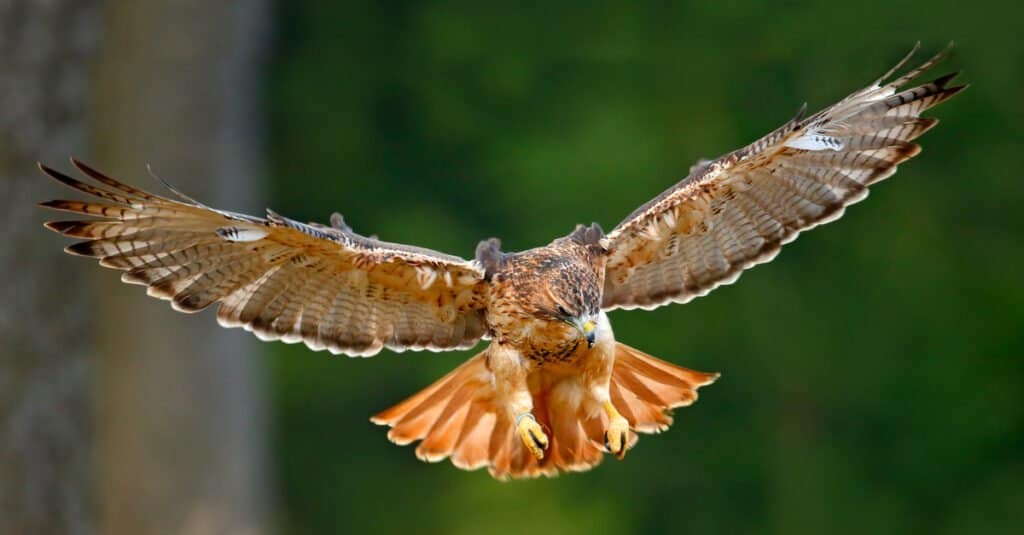
Red-tailed hawks have a diet that consists mainly of other small birds, small mammals, and snakes.
©Ondrej Prosicky/Shutterstock.com
| Red-tailed Hawk | |
|---|---|
| Scientific name | Buteo jamaicensis |
| Weight | 1.5-3.5 lbs (680-1586 g) |
| Height | 18-26 in (45-65 cm) |
| Wingspan | 43-56 in (110-141 cm) |
Deriving their name from the color of their tail, which is brick red, red-tailed hawks have a white feathered belly and are most common in the southern region of Wisconsin. They are solitary birds with a distinctive raptor scream. They are often spotted perched on lone trees or fence posts by the roadside.
Their diet consists mainly of other small birds, small mammals, and snakes. They hunt by watching for prey from a raised perch or by soaring low over fields. Red-tailed hawks are vulnerable to predation by great-horned owls.
Both sexes build their nests high up in tall trees or cliff ledges and mate for life. The female lays 2-3 eggs, which both parents take turns sitting on until they are hatched. They feed their young until about 6 weeks, after which they can now leave the nest.
2. Red-shouldered Hawk
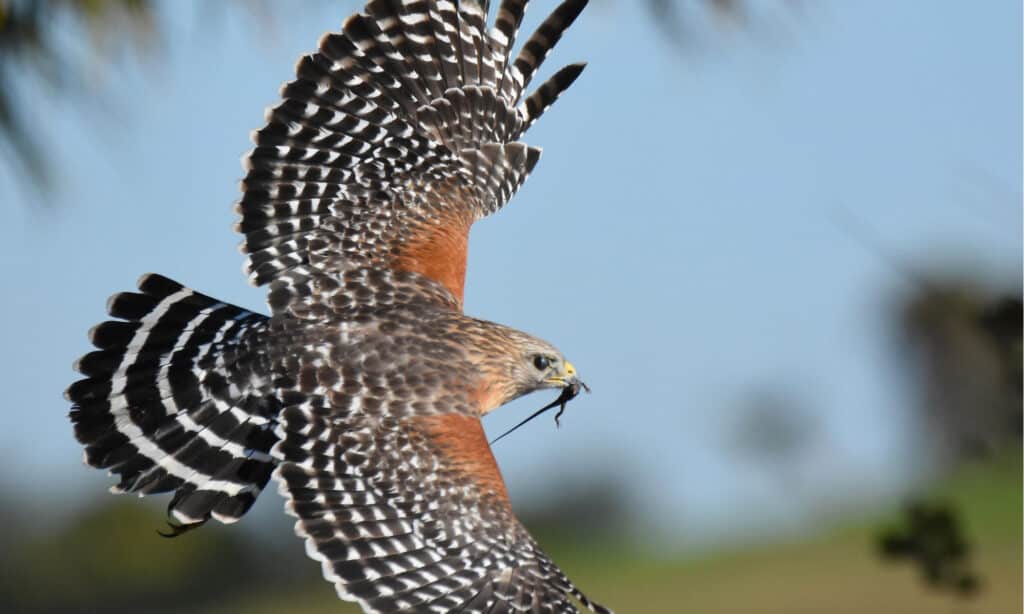
Red-shouldered hawks are marked with a rufous color on their shoulders and a rusty color on their underparts.
©MTKhaled mahmud/Shutterstock.com
| Red-shouldered Hawk | |
|---|---|
| Scientific name | Buteo lineatus |
| Weight | 1-1.7 lbs (486-774 g) |
| Height | 15-24 in (38-61 cm) |
| Wingspan | 35-50 in (90-127 cm) |
Red-shouldered hawks are marked with a rufous color on their shoulders and a rusty color on their underparts. They are medium in size, almost the size of a swan or a crow, with dark-and-white banded tails.
These hawks have a heavy presence in the most forested, wet areas of Wisconsin, such as the Chippewa River, Mississippi River, Wisconsin River, Kettle Moraine, and Wolf River. They nest in deciduous or mixed forests, often along rivers and swamps. The nest may be used for more than one season. Females lay 3-4 eggs that hatch in around 33 days.
Their diet is adaptable and comprises mostly small mammals during dry periods, amphibians and arthropods during wet seasons. They also feed on fish and small reptiles occasionally. Great horned owls, peregrine falcons, and martens prey on red-shouldered hawks.
3. Broad-winged Hawk
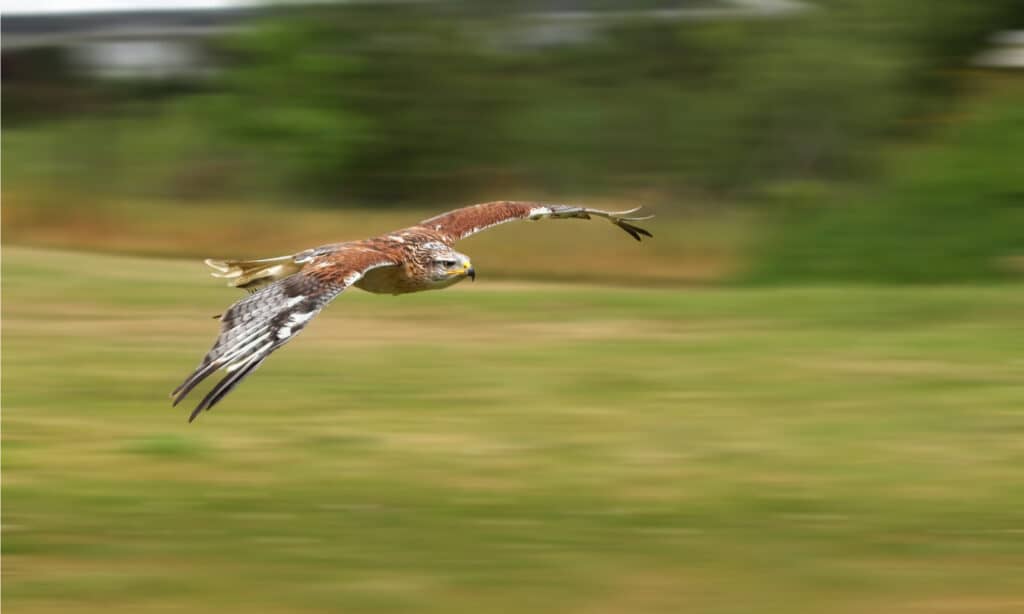
Broad-winged hawks build their nests in mixed coniferous-deciduous or pure deciduous forests.
©pr2is/Shutterstock.com
| Broad-winged Hawk | |
|---|---|
| Scientific name | Buteo platypterus |
| Weight | 9.3-19.8 oz (264-561 g) |
| Height | 13.4-17.3 in (34-44 cm) |
| Wingspan | 31.9-39.4 in (81-100 cm) |
Broad-winged hawks are fairly small birds of prey with stocky bodies. They derive their name from the size of their wings, which are relatively broad. They are widespread during the summer season in the north and not very common in Wisconsin’s west and central regions. They reside in the state from April to October, mainly to breed, after which they migrate south for the winter. Also, they are highly concentrated along Lake Michigan.
Broad-winged hawks have black-and-white banded tails with reddish-brown heads. Their undersides are pale with dark-brown borders. At juvenile stages, they have light brown feathers and streaked underparts.
These hawks feed on frogs, snakes, young turtles, and small mammals. They hunt by flying through the woods in an attempt to surprise the unsuspecting prey. They also hunt by watching for prey from a raised perch. In turn, they are vulnerable to predation by golden eagles, bald eagles, and great-horned owls.
Broad-winged hawks build their nests in mixed coniferous-deciduous or pure deciduous forests. Both sexes build the nests using sticks and softer materials like moss and bark. They are also known to reuse the nests of other animals, like squirrels or crows. Females lay between 2-3 eggs that are incubated for about 28-31 days.
4. Northern Harrier
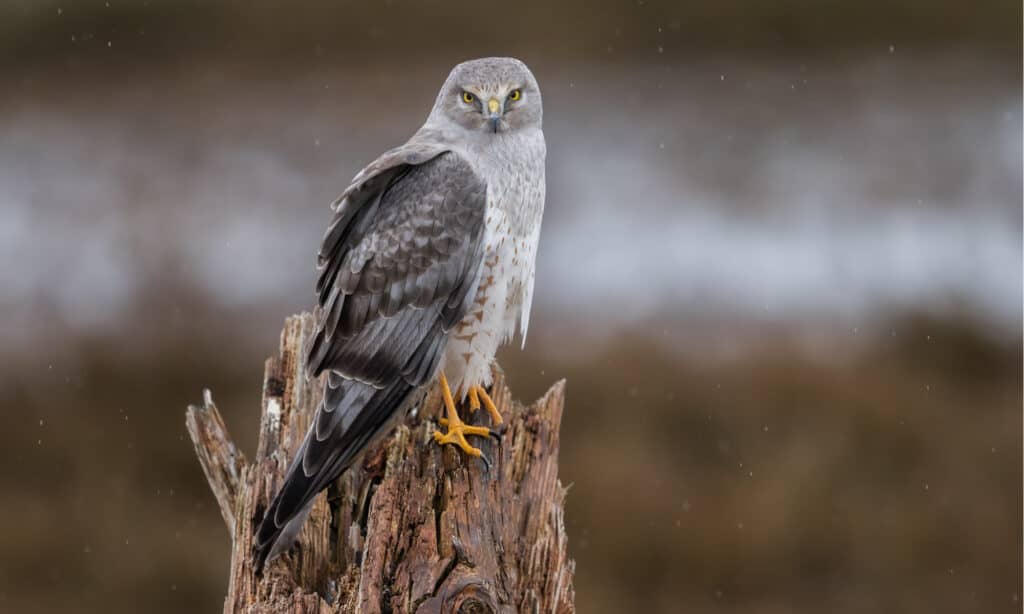
Northern harriers are medium-sized raptors, slender with relatively broad wings.
©Harry Collins Photography/Shutterstock.com
| Northern Harrier | |
|---|---|
| Scientific name | Circus hudsonius |
| Weight | 11-27 oz (300-750 g) |
| Height | 21-25 in (53-64 cm) |
| Wingspan | 41-46 in (103-117 cm) |
Northern harriers are medium-sized raptors, slender with relatively broad wings. Their faces resemble that of an owl with a sharply hooked small bill. They often fly with their wings held in a V shape. Females and immature ones have black bands on their tails and are generally brown. Males have black wingtips, whitish underbelly, and grey upper side, while females have brown streaks and a whitish underside. They are most prevalent in Wisconsin from April to October.
These hawks fly low over fields and marshy areas as they forage. They feed on mice, rats, lizards, small birds, rabbits, frogs, fish, and many other small mammals. Northern harriers are preyed on by feral cats, red foxes, and striped skunks.
Northern harriers build their nests in concealed areas on the ground or in wetland vegetation. Females build the nests while males supply the materials. The female lays between 4-6 pale-bluish eggs that hatch in about 30-32 days.
5. Cooper’s Hawk
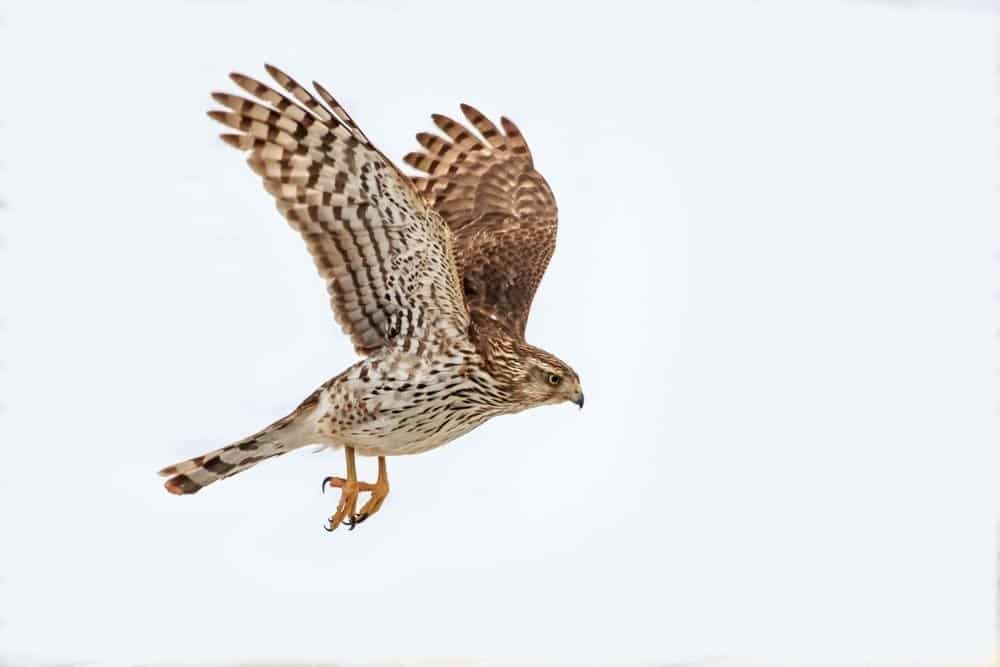
Cooper’s hawks are vulnerable to predation by American crows, raccoons, great-horned owls, and other large hawks.
©Richard G Smith/Shutterstock.com
| Cooper’s Hawk | |
|---|---|
| Scientific name | Accipiter cooperii |
| Weight | 7.8-14.5 oz (220-410 g) |
| Height | 14-20 in (35-50 cm) |
| Wingspan | 24-39 in (62-99 cm) |
Also commonly known as the “chickenhawk of America,” these hawks are native to Wisconsin and can be found all year round in the whole state, but migrate further north in the spring to breed. Juveniles have white spots on their upper wing covers and brown on their underparts with rufous edges. Adults are blue above with reddish feathers in their bellies. Females are bigger than males.
Cooper’s hawks mainly feed on small birds and mammals. They are often sighted in backyards and around bird feeders, trying to catch songbirds and other birds. They kill prey by consistently squeezing using their talons or even by sometimes drowning. These hawks are vulnerable to predation by American crows, raccoons, great-horned owls, and other large hawks.
Males build their nests on tall trees in mixed woods, coniferous, and deciduous forests. Females lay 3-5 pale blue-whitish eggs. The incubation period lasts about 34-36 days and is done mainly by females.
6. Northern Goshawk
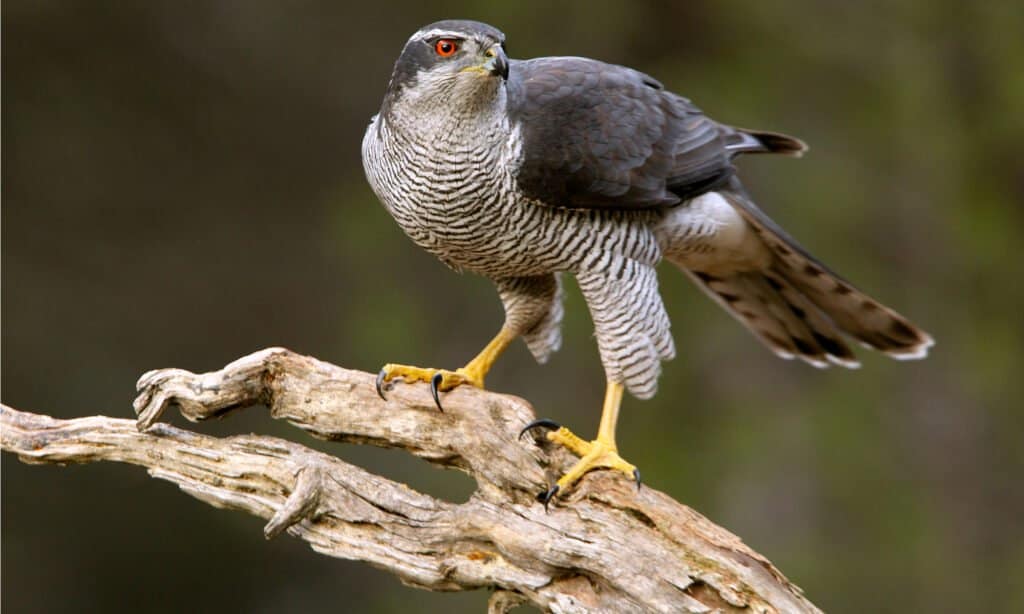
Northern goshawks mainly feed on medium-sized birds such as crows and grouse.
©Jesus Giraldo Gutierrez/Shutterstock.com
| Northern Goshawk | |
|---|---|
| Scientific name | Accipiter gentilis |
| Weight | 1.4-4.8 lbs (635-2177 g) |
| Height | 18-27 in (46-69 cm) |
| Wingspan | 40-46 in (103-117 cm) |
Northern goshawks are medium-to-large diurnal hawks. They have pale-gray underparts with silver-gray wings. The immatures have brown feathers across their wings and chest. They have broad, rounded wings with long tails. Northern goshawks are commonly found in Wisconsin throughout the year.
These hawks mainly feed on medium-sized birds such as crows and grouse. They also capture large animals like snowshoe hares, rabbits, and squirrels. They watch for prey from raised perches or by flying through the woods.
Their habitat is in the deciduous and coniferous forests, where they build their nests on high trees. Females lay between 2-5 eggs that hatch in about 32-38 days. Females mostly do incubation while males provide food for them.
7. Sharp-shinned Hawk
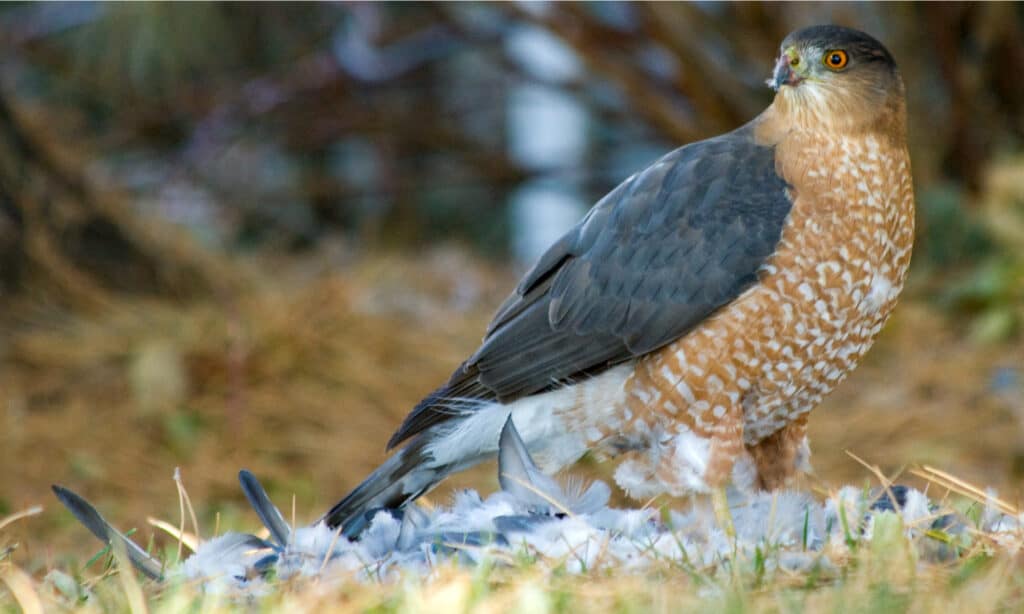
Sharp-shinned hawks have a diet that consists of small birds, squirrels, frogs, snakes, and lizards.
©Wyatt W/Shutterstock.com
| Sharp-shinned Hawk | |
|---|---|
| Scientific name | Accipiter striatus |
| Weight | 2.9-7.7 oz (82-219 g) |
| Height | 9.1-15 in (23-37 cm) |
| Wingspan | 17-27 in (42-68 cm) |
Sharp-shinned hawks are small-sized hawks with short, broad wings and medium-length black-and-gray banded tails. The juveniles have brown-black feathers, white spots on their wing coverts, and pale yellow eyes. The adults have bluish-gray on top.
These hawks usually nest in groves of deciduous or coniferous trees. Both sexes bring the nesting materials, but females do most of the construction work. Females lay 4-5 bluish-white eggs, blotched with brown.
Sharp-shinned hawks have a diet that consists of small birds, squirrels, frogs, snakes, and lizards. They hunt by flying low over the ground or through the woods, threading their way around obstacles and taking prey by sudden surprise. They also perch on foliage and wait for prey to approach.
8. Rough-legged Hawk
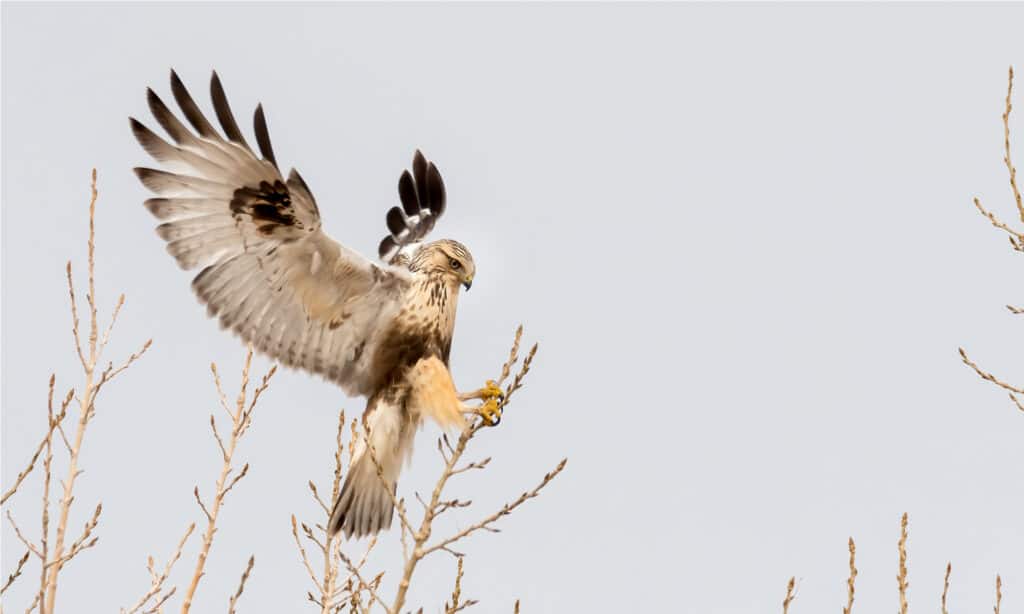
Rough-legged hawks are susceptible to predation by numerous eagles and large falcons.
©Eivor Kuchta/Shutterstock.com
| Rough-legged Hawk | |
|---|---|
| Scientific name | Buteo lagopus |
| Weight | 1.32-3.66 lbs (599-1660 g) |
| Height | 18-24 in (46-60 cm) |
| Wingspan | 52-54 in (132-138 cm) |
Rough-legged hawks derive their name from their feathered legs. They are often spotted in Waushara County. They are the only hawks that are tied to cold climates. They are pretty large raptors with broad wings. These raptors are dark-brown above with dark tail tips.
Rough-legged hawks mainly inhabit the tundra escarpments. They nest on a narrow ledge or high cliffs. Females lay between 3 and 5 pale bluish-white eggs with brown markings. The incubation takes roughly 31 days and is done mainly by females.
Their diet consists of lemmings and voles. They also eat small birds, squirrels, frogs, and large insects. These hawks usually hunt by hovering over fields, scanning for prey movement below. They also hunt from raised perches. Rough-legged hawks are susceptible to predation by numerous eagles and large falcons.
The photo featured at the top of this post is © Henk Bogaard/Shutterstock.com
Thank you for reading! Have some feedback for us? Contact the AZ Animals editorial team.






